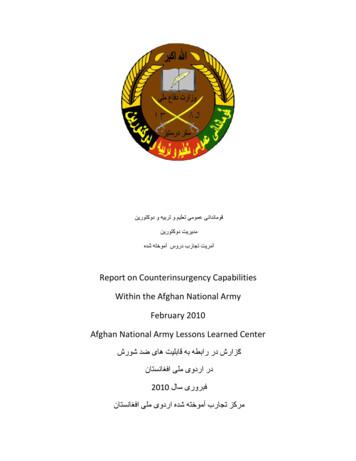Tactics Counterinsurgency
FMIFMI 3-24.2 (FM 90-8, FM 7-98)TacticsinCounterinsurgencyMARCH 2009HEADQUARTERSDEPARTMENT OF THE ARMYDISTRIBUTION RESTRICTION:Approved for public release, distribution is unlimited.
* FMI 3-24.2 (FM 90-8, FM 7-98)HeadquartersDepartment of the ArmyWashington, DC,Field Manual InterimNo. 3-24.2Tactics in CounterinsurgencyContentsPagePREFACE . viiiINTRODUCTION . ixChapter 1OPERATIONAL ENVIRONMENT OF COUNTERINSURGENCY . 1-1Section I—OVERVIEW. 1-1Insurgency. 1-1Counterinsurgency. 1-2Influences on Current Operational Environments. 1-2Section II—OPERATIONAL AND MISSION VARIABLES . 1-3Operational Variables . 1-3Mission Variables. 1-6Section III—ANALYSIS OF CIVIL CONSIDERATIONS USING ASCOPE. 1-8Methodology. 1-8Civil Considerations Overlay.1-10Civil Consideration Matrixes .1-10Section IV—EFFECTS .1-17Prerequisites .1-17Root Causes .1-18Section V—CULTURAL COMPETENCE AND SITUATIONAL AWARENESS .1-19Culture.1-19Cultural Capability.1-24Cultural Proficiency Levels.1-25Culturally Influenced Situational Awareness .1-26Chapter 2FOUNDATIONS OF INSURGENCY .2-1Section I—OVERVIEW. 2-1Components. 2-1Manifestations .2-1Historical Insurgency. 2-2Section II—ELEMENTS . 2-2Leaders . 2-3Guerrillas. 2-4Distribution Restriction: Approved for public release; distribution is unlimited.* This publication supersedes FM 90-8, 29 August 1986 and FM 7-98, 19 October 1992.FMI 3-24.2i
ContentsUnderground. 2-4Auxiliaries . 2-4Mass Base. 2-5Example. 2-5Section III—DYNAMICS . 2-5Leadership. 2-6Objective. 2-7Ideology . 2-9Environment and Geography . 2-11External Support. 2-11Internal Support . 2-12Phasing and Timing. 2-15Organizational and Operational Patterns . 2-16Section IV—STRATEGIES . 2-16Urban Strategy . 2-17Military-Focused Strategy. 2-17Protracted Popular War Strategy . 2-17Identity-Focused Strategy . 2-18Conspiratorial Strategy. 2-18Section V—TACTICS . 2-20Violent Tactics . 2-20Nonviolent Tactics . 2-23Section VI—STRENGTHS AND VULNERABILITIES . 2-24Strengths . 2-24Vulnerabilities . 2-25Chapter 3FOUNDATIONS OF COUNTERINSURGENCY . 3-1Section I—OVERVIEW . 3-1Definition of Counterinsurgency . 3-1Goal of Counterinsurgency Operations. 3-1Foreign Internal Defense. 3-2Internal Defense and Development. 3-2Joint, Interagency, Intergovernmental, Multinational. 3-2Interagency Coordination in COIN . 3-5Lines of Effort in Counterinsurgency . 3-7Section II—HISTORICAL THEORIES. 3-9Robert Thompson's Principles for Successful COIN. 3-9David Galula’s Four Laws for Successful COIN. 3-9Charles Callwell’s Ideas for Successful COIN . 3-10Section III—TACTICAL CONSIDERATIONS. 3-10Terrain . 3-10Troops . 3-14Section IV—CLEAR-HOLD-BUILD OPERATIONS. 3-17Overview. 3-18Clear . 3-19Hold . 3-20Build. 3-21iiFMI 3-24.2
ContentsSection V—OTHER MAJOR COIN TACTICAL OPERATIONS.3-23Strike Operations .3-23Populace and Resource Control Operations .3-24Section VI—PHASES.3-27Initial Response Phase .3-27Transformation Phase.3-28Fostering Sustainability Phase .3-28Chapter 4COMPREHENSIVE TACTICAL PLANNING IN COIN . 4-1Section I—OVERVIEW. 4-1End State . 4-1Measures of Performance and Effectiveness.4-2Planning Horizons. 4-3Section II—TACTICAL DESIGN . 4-5Considerations . 4-6The Seven Counterinsurgency Lines of Effort. 4-6Section III—MDMP AND TLP .4-14Military Decision-Making Process.4-14Troop-Leading Procedures .4-23Section IV—TARGETING INSURGENTS .4-27Role in COIN .4-27Counterinsurgency Targeting Process .4-28Targeting of Battle Rhythm .4-32Chapter 5OFFENSIVE CONSIDERATIONS IN COIN. 5-1Section I—OVERVIEW. 5-1Purpose in COIN. 5-1Characteristics of the Offense . 5-2Types of Offensive Operations . 5-2Offensive Operations in Clear, Hold, Build Operations . 5-3Mission Variables in COIN . 5-3Section II—CIVIL SECURITY AND CONTROL. 5-4Search and Attack. 5-4Cordon and Search.5-8Search Operations .5-15Site Exploitation .5-17Raid.5-23Ambush .5-25Sniper Operations .5-31COIN Patrols .5-33Section III—OTHER LINES OF EFFORT .5-39Support Host Nation Security Forces .5-39Support to Governance.5-39Restore Essential Services .5-40Support to Economic and Infrastructure Development.5-40Conduct Information Engagement .5-40Chapter 6DEFENSIVE CONSIDERATIONS IN COIN. 6-1FMI 3-24.2iii
ContentsSection I—OVERVIEW . 6-1Area Defense. 6-1Mobile Defense. 6-1Retrograde. 6-1Major Counterinsurgency Operations . 6-2Section II—CIVIL SECURITY AND CONTROL . 6-2Site Selection. 6-2Protection . 6-7Counterinsurgency Bases . 6-8Planning Considerations for a Base Defense . 6-10Combat Outpost Construction Considerations. 6-12Base Defense . 6-14Counter Ambush. 6-17Countering IEDs . 6-18Countersniper or Sniper Defeat. 6-26Countering Drive-By Shootings . 6-30Section III—OTHER LINES OF EFFORT. 6-31Support Host Nation Security Forces . 6-31Support to Governance . 6-31Restore Essential Services . 6-31Support to Economic and Infrastructure Development . 6-32Conduct Information Engagement. 6-32Chapter 7STABILITY OPERATIONS CONSIDERATIONS IN COIN . 7-1Section I—OVERVIEW . 7-1Nature of Stability Operations . 7-1Clear-Hold-Build Operations . 7-2Section II—FIVE PRIMARY STABILITY TASKS. 7-2Establish Civil Security . 7-2Establish Civil Control. 7-5Support to Governance . 7-15Restore Essential Services . 7-21Support to Economic and Infrastructure Development . 7-23Chapter 8SUPPORT TO HOST NATION SECURITY FORCES . 8-1Section I—BENEFITS, CHALLENGES, AND GOALS. 8-1Benefits. 8-1Challenges. 8-2Goals . 8-4Section II—THE FRAMEWORK . 8-4Developing a Plan . 8-4Developing HN Security Forces . 8-7Employment of Newly Trained Forces in COIN . 8-24Appendix AivIPB IN COIN.A-1Overview. A-1Signifigant Characteristics in COIN . A-2FMI 3-24.2
ContentsAppendix BREADINGS FOR COIN TACTICAL LEADERS IN A TIME-CONSTRAINEDENVIRONMENT . B-1Appendix CTWENTY-EIGHT ARTICLES: FUNDAMENTALS OF COMPANY-LEVEL COIN . C-1Introduction . C-1What is Counterinsurgency?. C-1Preparation. C-2Golden Hour. C-4Groundhog Day. C-6Getting Short . C-8Four “What Ifs” . C-8Appendix DTWENTY-SEVEN ARTICLES OF T.E. LAWRENCE . D-1GLOSSARY . Glossary-1REFERENCES . References-1INDEX. Index-1FiguresFigure 1-1. Comparison of insurgent's and counterinsurgent's perspectives of time. .1-6Figure 1-2. ASCOPE. .1-8Figure 1-3. Civil considerations overlay. .1-10Figure 1-4. Taxonomy of culture.1-20Figure 1-5. Changes in cultural capability over time. .1-25Figure 2-1. Insurgency.2-2Figure 2-2. Components of Malaysian Insurgency (circa 1950).2-2Figure 2-3. Organizational elements of an insurgency. .2-3Figure 2-4. Example insurgent organization. .2-5Figure 2-5. Range of popular support.2-12Figure 2-6. Shifts between strategies and phases.2-20Figure 3-1. Full-spectrum operations.3-6Figure 3-2. Example lines of effort for a counterinsurgency.3-8Figure 3-3. Rheostat approach to the lines of effort.3-9Figure 3-4. Example format for AO platoon requirements worksheet. .3-15Figure 3-5. Clear-hold-build framework. .3-18Figure 4-1. Lines of effort. .4-8Figure 4-2. COIN MDMP. .4-17Figure 4-3. Course of action analysis (wargame). .4-20Figure 4-4. Example expanded synch(ronization) matrix.4-22Figure 4-5. TLPs in COIN. .4-24Figure 4-6. Lethal and nonlethal targeting. .4-28Figure 4-7. Targeting and MDMP. .4-29Figure 4-8. Targeting of battle rhythm. .4-32Figure 5-1. Infiltration by company. .5-7Figure 5-2. Infiltration by squad/platoon. .5-7FMI 3-24.2v
ContentsFigure 5-3. Comparison of cordon and search methods.5-9Figure 5-4. Typical organization for cordon and search operations. .5-11Figure 5-5. Typical establishment of an urban cordon. .5-14Figure 5-6. Urban inner cordon.5-14Figure 5-7. Example site exploitation sketch. .5-18Figure 5-8. Example raid concept. .5-24Figure 5-9. Linear formation ambush.5-29Figure 5-10. L-shaped formation ambush.5-30Figure 5-11. Satellite patrol movement. .5-38Figure 6-1. Example format for Vulnerability Prioritization Matrix. .6-3Figure 6-2. Example completed CARVER-P Vulnerability Prioritization Matrix.6-3Figure 6-3. Criteria evaluation tool.6-4Figure 6-4. Facility categories.6-6Figure 6-5. Typical US combat outpost design. .6-13Figure 6-6. Organization of base command.6-15Figure 6-7. Base defense elements forces. .6-16Figure 6-8. Key base defense structures. .6-16Figure 6-9. Coordinates register. .6-20Figure 6-10. Example pattern-analysis plot sheet.6-21Figure 6-11. Example activities matrix. .6-22Figure 6-12. Example association matrix.6-23Figure 6-13. Example link diagram. .6-23Figure 6-14. Types of snipers. .6-27Figure 7-1. Example BCT using LOEs.7-2Figure 7-2. Well-equipped snap checkpoint layout. .7-10Figure 7-3. Typical enduring checkpoint layout.7-11Figure 7-4. Legitimate governance. .7-16Figure 8-1. Partnership benefits. .8-2Figure 8-2. Host nation contributions. .8-2Figure 8-3. Characteristics of well-trained HN security forces. .8-5Figure 8-4. Possible duties of the advisor team.8-7Figure 8-5. Seven framework tasks. .8-8Figure 8-6. Example format for readiness assessment.8-9Figure 8-7. Augmentation of an example unit. .8-18Figure 8-8. Principles of advising.8-21Figure 8-9. Team-building process. .8-23Figure 8-10. Example Host Nation security force AAR—operation summary. .8-24Figure A-1. The steps of IPB. . A-1Figure A-2. Significant terrain characteristics common to COIN operations. . A-4Figure A-3. Societal considerations. . A-6TablesTable 1-1. Typical civil considerations within each ASCOPE category. .1-9viFMI 3-24.2
ContentsTable 1-2. Example area matrix.1-12Table 1-3. Example structures matrix. .1-13Table 1-4. Example capabilities matrix. .1-14Table 1-5. Example organizations matrix. .1-15Table 1-6. Example people (means of communications) matrix. .1-16Table 1-7. Example event matrix. .1-17Table 2-1. Insurgent strengths and countermeasures. .2-24Table 2-2. Insurgent vulnerabilities and considerations. .2-26Table 3-1. US governmental organizations. .3-4Table 4-1. COIN long-range planning cycle.4-4Table 4-2. COIN mid-range planning cycle.4-5Table 4-3. COIN short-range planning cycle.4-5FMI 3-24.2vii
PrefaceThis field manual establishes doctri
This field manual establishes doctrine (fundamental principles) for tactical counterinsurgency (COIN) operations at the company, battalion, and brigade level. It is based on lessons learned from historic counterinsurgencies and current operations. This manual
1.1 Using Tactics in Practice 2 2 Tactics for Availability 5 2.1 Updating the Tactics Catalog 6 2.2 Fault Detection Tactics 6 2.3 Fault Recovery Tactics 10 2.4 Fault Prevention Tactics 16 3 An Example 19 3.1 The Availability Model 19 3.2 The Resulting Redundancy Tactic 21 3.3 Tactics Guide Architectural Decisions 22 .
Afghan National Army's Counterinsurgency Director's assessment of counterinsurgency capabilities across the Afghan National Army. In order to assess counterinsurgency operations in the Afghan National Army, a Collections and Analysis Team from the Afghan Lessons Learned Center visited ANATC Training Centers and the Corps to gather .
tactics and discuss the range of tactics identified by research, as well as their effects on various outcomes. Impression management tactics Research has identified a range of IM tactics and has found several ways to classify these tactics. The simplest distinction views IM tactics as either verbal or non-verbal (Schneider, 1981).
ADHOME HVAC MARKETING FUNNEL AWARENESS INTEREST CONSIDERATION INTENT EVALUATION PURCHASE DESCRIPTION MARKETING TACTICS MARKETING TACTICS MARKETING TACTICS MARKETING TACTICS MARKETING TACTICS MARKETING TACTICS DESCRIPTION DESCRIPTION DESCRIPTION DESCRIPTION DESCRIPTION Someone in this stage is hearing about your brand for the first time. They .
A CIA review of high-value targeting (HVT) programs worldwidea suggests that HVT operations can play a useful role when they are part of a broader counterinsurgency strategy. HVT operations are most likely to contribute to successful counterinsurgency outcomes when governments decide on a d
The Wildland Fire Suppression Tactics Reference Guide is designed to . supplement courses that teach tactics in the Wildland Fire Qualification System. It can be used by the beginning firefighter to learn basic tactics as well as a review of fire suppression tactics for the advanced firefighter.
Negotiation tactics can work to strengthen the relationship or can be used to intimidate, discourage, anger or upset the other party. Tactics can be skillfully planned or just happen in the course of a negotiation. Tactics that are intended to intimidate, surprise, or tip the power balance are labeled in this reading as "Adversarial Tactics". .
Web Hooks and API integration Add validations and extensions from the marketplace or build your own using web hooks and REST APIs. Semantic code search Quickly find what you’re looking for with code-aware search that understands classes and variables. Getting Started with Azure DevOps Azure Pipelines Cloud-hosted pipelines for Windows, macOS, with unlimited minutes for open source page 013 .























